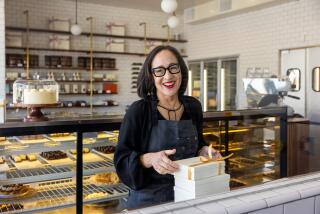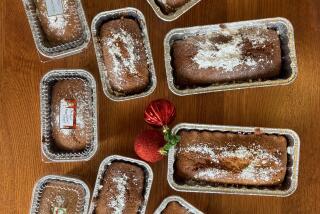Recipes for Chocolate That Are a Joy Forever
A well-written recipe is a thing of beauty. Without going all postmodernist on you, that’s true quite apart from how the dish it describes tastes. Theoretically, you could have a perfectly written recipe for how to prepare a perfectly awful dish. Well, come to think of it, that’s not really all that theoretical, is it?
What brings this to mind is Dorie Greenspan’s new book “Chocolate Desserts by Pierre Herme” (Little, Brown and Co., $40). Well, obviously it’s not just her book. After all, Herme is one of the most famous pastry chefs in France, and the dishes are undoubtedly his creations.
But the descriptions of how they are made are Greenspan’s, and that is what separates this from so many other big-deal chef books. Greenspan is one of the few recipe writers who is able to convey an actual sense of voice. Read her instructions and you sense a real person there, someone who is a good cook, who has prepared this recipe before and who is there to help you should you stumble.
This comes across in a series of asides that fit seamlessly into the directions. When you’re mixing the batter for the “saucer-sized spicy chocolate sables,” for example, Greenspan is at your elbow with a warning: “This is a delicate dough and you don’t want to overmix it, so stop as soon as the last speck of flour disappears. You’ll have a very soft dough.”
Then there’s the canny advice in the recipe for creme brulee: After you’ve beaten some of the hot milk into the yolk mixture (to “acclimatize” them), “rap the bowl against the counter to burst any bubbles, then pour the custard through a strainer into a pitcher.” Isn’t that a neat trick?
For cookbook fans--or should I say “recipe-writer fans”?--this is not news. Greenspan has a history of taking on such projects, starting in 1996, when she wrote the recipes for the companion book to Julia Child’s PBS series “Baking With Julia.” In 1998 she did “Desserts by Pierre Herme”; in 1999 it was “Daniel Boulud’s Cafe Boulud Cookbook.”
In fact, it’s a little scary to think about what “Chocolate” might have been like without Greenspan’s hand. The dishes are probably delicious, and the photography by Jean-Louis Bloch-Laine is sumptuous--dessert getting the kind of carefully lit, strikingly composed treatment usually afforded only to movie stars and new cars.
But given all that, without Greenspan’s calming influence, the recipes seem the type to induce fainting spells among readers who are not professional pastry chefs (or who didn’t just buy it for the pictures). These are all-day undertakings, for the most part, requiring the preparation of several sub-recipes. They’re as much construction projects as desserts.
But hey, who buys a book by a French pastry chef if they’re not interested in putting in some quality kitchen time?
And look at it this way: All that work just gives you the opportunity to more deeply appreciate what a beautiful thing a truly well-written recipe is.
More to Read
Eat your way across L.A.
Get our weekly Tasting Notes newsletter for reviews, news and more.
You may occasionally receive promotional content from the Los Angeles Times.











